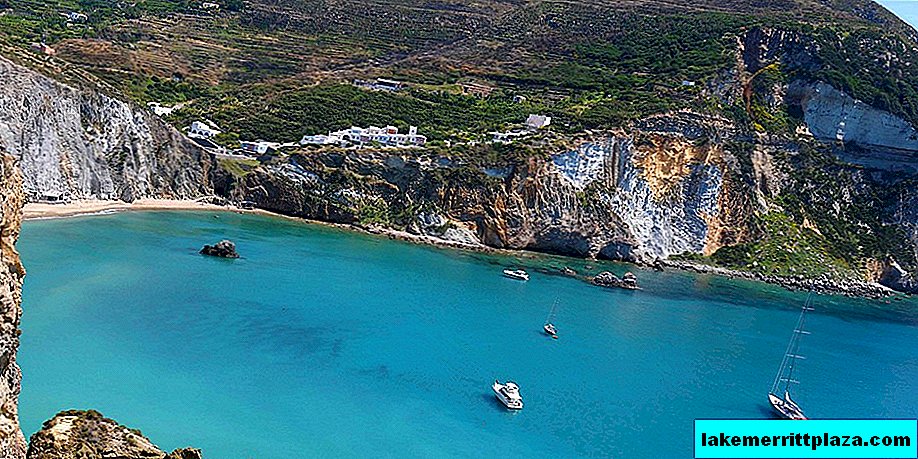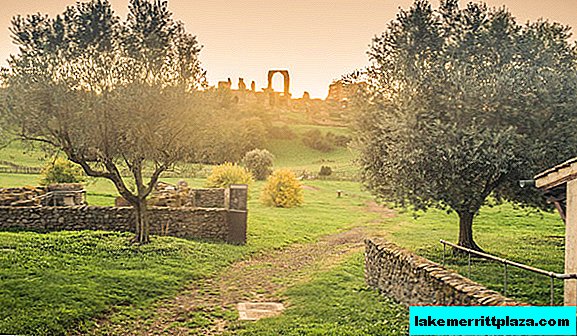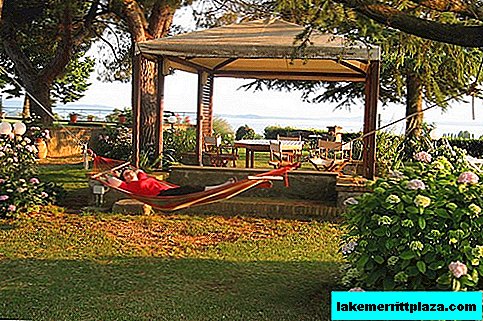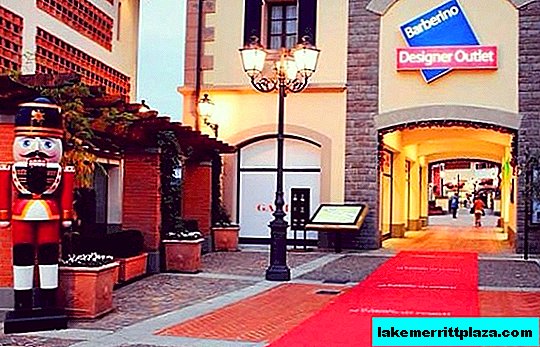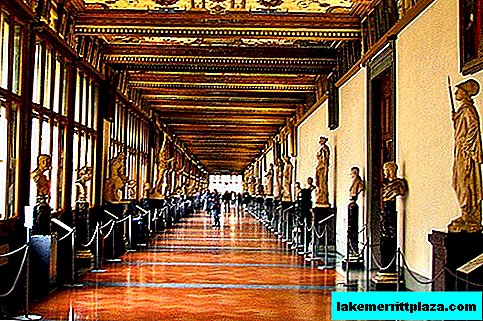Doge's Palace, aka Palazzo Ducale - is the main attraction of Venice, an architectural monument of Italy, made in the Gothic style.The author of the project is Filippo Calendario (Calendario).
Construction history
The construction of the palace took place over the course of 115 years 1309-1424. In 1577, a fire occurred, significantly damaging the building. The palace was restored in the old style despite the dawn of the Renaissance architecture. The building was the residence of the Doges. Doge is the head of the board of the Republic of Venice, who was elected for life by a multi-stage vote.
Doge contenders came from the most influential clans of Venice. The Doge Institute lasted more than a thousand years; Napoleon abolished it in 1797.

Also in the palace were the Senate, the Grand Council, the Collegium, the Supreme Court, the Maritime Department, the secret police and other representatives of the state apparatus. Doge's Palace differs from its contemporary palaces in that it is not a fortress
Who was located in the walls of the Doge's Palace
Despite its name, the premises of the Doge's Palace served not only as the residence of the rulers of the Republic of St. Mark. The personal apartments of the head of Venice occupied only the northern wing of the building. The palazzo also held meetings of members of the Grand Council and the Senate. Hearings of the Supreme Court took place here, the secret police and the Inquisition worked. On the ground floor there were legal offices, a chancellery, a maritime department and other municipal institutions. Thus, the Doge's Palace was the home of the government of Venice, an amazing city-state that did not know the sole authority for several centuries of its colorful history.
Tickets, excursions, opening hours
Now a museum is open in the ancient walls of the palazzo, open to visitors daily. Guests are invited to see the stunning decoration of the Doge's Palace halls on their own or as part of tour groups. Visiting the secret rooms of the Doge's Palace and the prison located on the top floor of the building is not included in the main excursion program and is paid extra.
Schedule from April 1 to October 31:
- Sunday - Tuesday, 8:30 - 21:00;
- Friday - Saturday, 8:30 - 23:00.
Schedule from November 1 to March 31:
- all days of the week, 8:30 - 19:00.
Group tours in Russian inside the Doge's Palace are conducted by tour operators. If you speak English, Italian, French, Spanish or German, I advise you to book a tour for 42 euros per person, which includes a ticket.
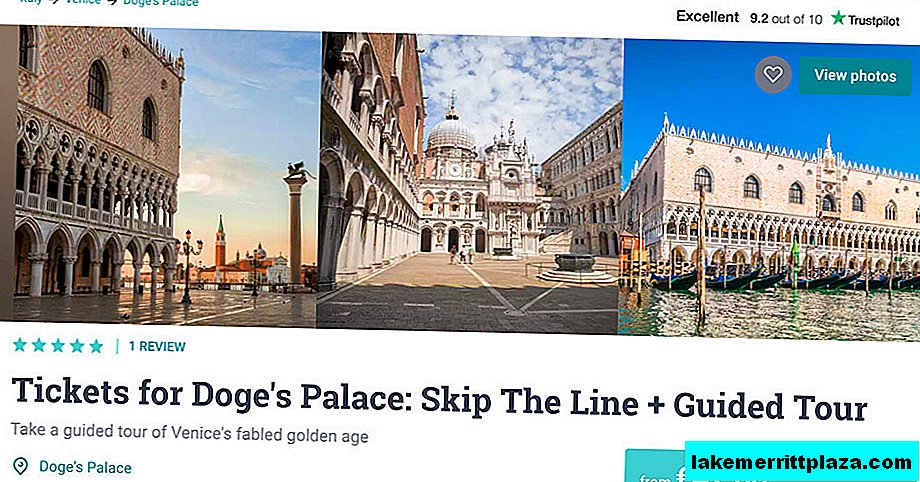
Particularly curious tourists should pay attention to the tour, which includes secret routes and rooms, inaccessible to ordinary visitors. Such an excursion costs 54 euros, it is carried out only by reservation, the start time is at 08:30 or 09:00 in the morning.
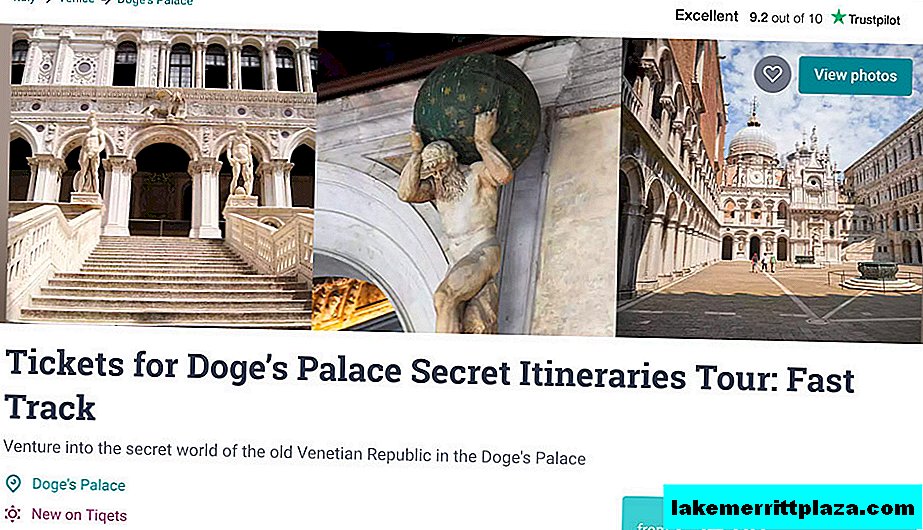
Official site: palazzoducale.visitmuve.it - here those who wish to visit the palace can order tickets online for 26 euros, so as not to stand in lines. A discount ticket for 15 euros is provided to holders of special tourist cards, children from 6 to 14 years old, students from 15 to 25 years old with an ISIC card. Be sure to present a document confirming the age and discount.
The purchase system is rather confused, so if you want to buy the same tickets in just two clicks or the tickets on the official website are over at the right time, I advise you to buy them here for 27.5 euros.

On the map below is the Doge's Palace and the main attractions of Venice:
View Venice's main attractions on a larger map
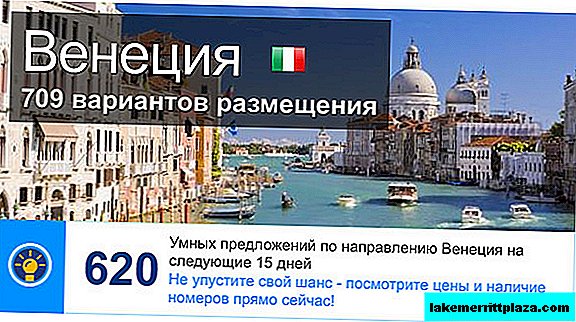
How the palace is arranged
The palace is a three-story building in the shape of the Russian letter "P", made of gray, white and pink marble. The building has two facades that form a right angle.
The first floor is a gallery of pointed arches, which are supported by columns.
The second floor is also formed by columns, but less thick and taller, and in the upper part there is a row of lodges decorated with a four-leaf ornament.
Third floor - a smooth wall lined with white marble, which is cut through large and small windows. On the southern facade there is a balcony, which was the platform of the Doge. A monument of Justice Alessandro Vittoria is installed over the balcony.

The perimeter wall is crowned with delicate white marble teeth. The palace has two main entrances:
- Porta della Carta, paper gates (Porta della Carta);
- The main entrance of the Doge's Palace.
Above the gate is the winged lion of St. Mark and in front of him on the lap of the Doge Francesco Foscari. Paper gates were called because of the tradition of posting announcements on them.
Porta del Frumento, wheat gate (Porta del Frumento) - overlook the promenade and are the starting point for tours of the palace.
Giants Staircase
A tour of the Palazzo Doge's halls begins for tourists from the patio. From there, the main staircase of the Giants (Scala dei Giganti) leads to the second floor, made of the most valuable type of marble, specially brought to Venice from the Apuan Alps (Alpi Apuane).
It got its name thanks to the huge stone statues of Mars and Neptune (Marte e Nettuno), installed in 1554 on the upper platform of the structure. The author of the sculptures symbolizing the power of the Queen of the Adriatic, as Venice was called at that time, is Jacopo Sansovino, a renowned master of the High Renaissance.
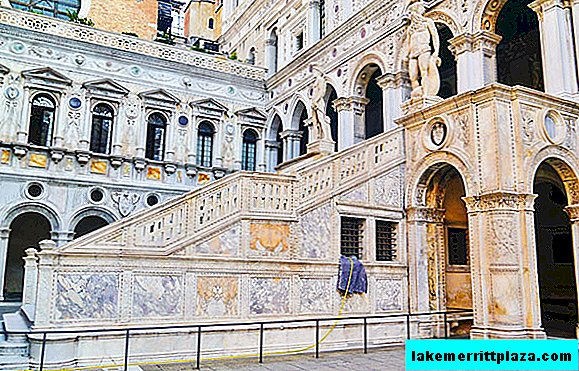
For several centuries, one of the most solemn and magnificent ceremonies of the Republic of St. Mark was held on the terrace crowning the Ladder of the Giants - the inauguration of the newly elected Doge. The next ruler received from the chief member of the Council a special headdress in the form of a brocade cap (Corno Ducale), symbolizing power.
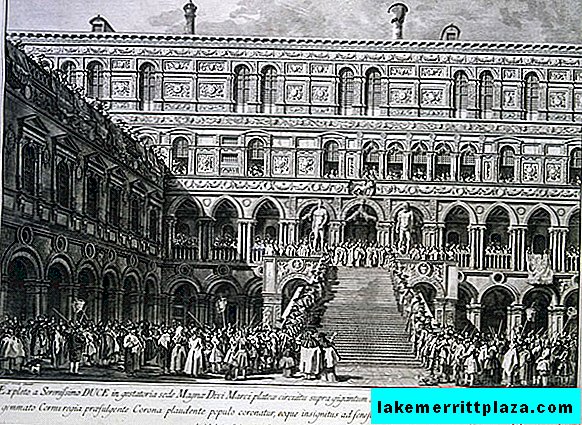
Walking up the Giants' Stairs, guests of the Doge's Palace find themselves in a covered gallery. Its walls, like other rooms of the palazzo, are decorated with relief images of sinister lion muzzles (bocca di leone).
Great Council Hall
The most impressive premises of the Doge's Palace is the Great Council Hall (Sala del Maggior Consiglio), located on the second floor of the palazzo. It occupies the entire southern wing of the building. Government meetings were held here of the main authority, which considered the main issues of domestic and foreign policy.

The huge area of the premises (1350 m2) is due to the fact that the number of members of the Grand Council who gathered to discuss important state affairs totaled from 1,000 to more than 2,000 people at different times in the existence of the Venetian Republic. The hall, which is one of the largest in Europe, is distinguished by an extraordinary architectural feature: with a 15-meter-high wall height, there are no columns and supports, and the ceiling is held by a unique system of attaching rafters to floor beams.
The interior is decorated with masterpieces of the leading masters of the Venetian school of painting, such as Tiziano Vecellio, Paolo Veronese, Tintoretto and many others. The devastating fire of 1577 almost destroyed the decoration of the walls and ceiling, but most of the great artists managed to participate in restoration work. The restoration was carried out under the guidance of the famous architect and engineer Antonio de Ponti (Antonio de Ponti). It contains a large part of the collection of portraits of Venetian Doges, arranged in chronological order, with the exception of the 55th ruler of the Republic of St. Mark, Marino Faliero, deprived of his title and sentenced to death for attempted coup d'etat. A series of images of the heads of state is continued in the neighboring Hall of Fate.
The beauty and grandeur of the room are enhanced by the monumental painting "Paradise", owned by the brush of 70-year-old Tintoretto. The great master and his students worked on large-scale work (7 X 22 m) for about 13 years. She adorns the wall with a pedestal where the Doge and six members of the Small Council once sat. A bewitching picture, striking with the unusual color scheme, the complexity of the composition and the depth of the allegorical meaning, is considered the largest oil painting in the world.
Hall of Fate
On the second floor of the Doge's Palace is also the Hall of Fate (Sala dello Scrutinio) or Elections (Voting). Initially, it served as a place to store books and manuscripts. In 1469, a true connoisseur and propagandist of ancient literature, Cardinal Vissarion presented the Venetian Republic with his most valuable collection, which included hundreds of manuscripts and prints in Latin and ancient Greek. Literary treasures, bequeathed to the greatest enlightener and humanist of the 15th century, formed the basis of the Marciana library, built several decades later.
Since 1532, in the premises of the Hall of Fate, officials began to run for senior government posts. Here, a complex, multi-stage procedure for the election of the Venetian Doges took place. The process of public voting often ended with convictions, so those present were forbidden to carry weapons.
The walls and ceilings of the Hall of Fame impress with its richness and pompous decor: in addition to large-scale paintings telling about the centuries-old military power of the Republic of St. Mark, the grandiose painting "The Last Judgment" adorning the southern part of the room deserves special attention. Its author is a bright representative of the Venetian school of painting, Jacopo Palma the Younger (Palma il Giovine).
Another spectacular decorative detail is the impressive Arch of Triumph, erected on the initiative of the Senate in honor of the brave Venetian Doge Francesco Morosini, famous for his brilliant victories in the Great Turkish War.
Stamp Hall (or Card Hall)
The Armorial Hall (Sala dello Scudo), located on the second floor of the palazzo, was part of the Doge’s personal apartment (Appartamento Ducale). The ruler of the city-state arranged an audience here for the guests of the palace. The peculiar reception room got its name for a reason. On the central wall, framed by a massive, gilded shield, hung a coat of arms belonging to the family of the ruling Doge.
The hall is decorated with two ancient globes (XVII century) and huge geographical maps created by Italian travel writer Giovan Battista Ramusio and natural scientist Francesco Griselini.
Scarlatti Hall
Scarlatti Hall (La Sala degli Scarlatti) is located next to the Doge's chambers. He served as a special room in which senior officials gathered and awaited the departure of the ruler of the state for ceremonies.
The decoration of the luxurious interior was carried out under the guidance of the sculptor and architect Pietro Lombardo. The main element of the decor is a wooden carved ceiling with exquisite gilded patterns. The walls are decorated with elegant bas-relief compositions. A huge fireplace made of snow-white marble gives the hall a special parade and solemnity. In its upper part, the family coat of arms of the 74th Doge of Agostino Barbarigo flaunts.
Grimani Hall
The magnificent Hall of Grimani (Sala dello Grimani) in the old days was one of the few Doge's rooms. He got his name thanks to the richest and most powerful Venetian clan, who gave the Republic of St. Mark three rulers. The wise policies of the members of an influential family have earned sincere love and respect for ordinary citizens. So, the Venetians rejoiced and had fun for several days, celebrating the inauguration of the 89th Doge Marino Grimani.
In the very center of the hall, a family coat of arms is placed on the ceiling, and the walls are decorated with paintings depicting the winged lion of St. Mark - the main symbol of the city on the water. The most famous work is the painting of the same name painted by Vittore Carpaccio depicting an Old Testament beast against the backdrop of the lagoon, victorious ships and the Doge's Palace itself.
Golden staircase
The covered gallery of the second floor of the Doge's Palace leads to the Golden Stairs (Scala d'Oro), passing through which you can get into the interior of the palazzo, located on the third tier. During the existence of the Republic of Venice, only high-ranking guests and titled citizens who held important government posts were allowed to enter this place. The names of aristocrats were immortalized in a special "Golden Book" (Libro d'Oro), records in which were kept from 1315.
The staircase project, elegantly decorated with luxurious stucco molding, marble sculptures and bas-reliefs, was created in 1538 by Jacopo Sansovino, and implemented almost 20 years later thanks to the work of the famous architect Antonio Abbondi.
Hall of Four Doors
The bright, spacious Hall of Four Doors (Sala della Quattro Porte) is the first room that visitors to the palazzo get to when they climb to the third floor. It served as a waiting room for people wishing to meet with members of the College, Senate and Council of Ten.
Marble columns and graceful sculptural groups adorn massive bronze doors. The magnificent stucco molding on a ceiling executed by Giovanni Cambi (Giovanni Cambi), strikes with ornate and incredible grace of lines. The authorship of the magnificent frescoes and paintings, narrating in allegorical form about the greatness of the Republic of St. Mark, belongs to Jacopo Tintoretto, Titian Vecellio and Giovanni Battista Tiepolo.
Hall of the Anti-College
The Hall of the Anti-College (Sala dell'Anticollegio) is a real treasury of masterpieces of painting created by masters in the second half of the 16th century. In a small area, foreign ambassadors and dignitaries who had arrived from other countries had once expected a reception. The mythological plots of the paintings embody the wisdom of the Venetian rulers. One of the most famous works of painting - "The Abduction of Europe", owned by Paolo Veronese.
The hall is decorated with a magnificent fireplace, decorated with marble statues of Atlantes, intricate sculptural groups and rhythmic ornaments. The luxurious interior was designed by the renowned architect Andrea Palladio, considered the founder of Italian classicism.
Boardroom
Within the walls of the magnificent Collegia Hall (Sala del Collegia) were pressing vital national and foreign policy issues of the Republic of Venice. The administrative, advisory and administrative body included several people. The college was primarily represented by the Doge himself and six of his advisers, "wise men." The Supreme Chancellor (Cancelliergrande), who, in fact, is the second person in the state, took part in making important decisions. The meetings were also attended by the heads of the Council of Ten. Here, meetings were held with foreign delegations, draft laws were drafted, which subsequently awaited the approval of the Senate.
The walls and the College Hall are decorated with 11 skillful canvases of Venetian masters of painting, framed by massive gilded frames. The ceilings are decorated with allegorical frescoes by Paolo Veronese. The artist’s brushes also include the work “Venice on the Throne with Justice and Peace”, an amazing painting, distinguished by its high technique of execution and deep symbolism.
Senate Hall
The Senate Hall (Sala del Senato) served as the venue for the meetings of the oldest authority, formed in the first quarter of the 13th century. By the sixteenth century, the number of representatives of this government unit totaled almost 300 people. All posts were elective. Senators, dressed in scarlet robes, unlike other Venetian patricians, were in charge of financial, trade and diplomatic affairs. In their competence were important issues regarding the army and navy.
The luxurious interior of the hall, decorated with paintings and gilded stucco, is complemented by an interesting detail: the walls are decorated with antique clocks with unusual dials. The arrows of some indicate the position of the Sun in the signs of the zodiac, while others indicate time, focusing on 24 Roman numerals. Particularly noteworthy is Tintoretto’s monumental painting “The Triumph of Venice, Lady of the Seas,” located in the central ceiling. The fascinating canvas delights with the complexity of the picture, the brightness of colors and the dynamism of the composition.
Compass Hall
The generally accepted name of the Compass Hall (Sala della Bussola) is often interpreted incorrectly, and in fact has nothing to do with the device that determines the cardinal points. The misunderstanding is explained by the linguistic subtleties of the translation from Italian into Russian. The ambiguous word "bussola" can be interpreted not only as "compass", but also as "instrument", "mechanism" or even "vestibule", which more accurately determines the purpose of this room.
The walls of the small hall have secret doors disguised as a cabinet decorated with a figure of justice. One of the secret passages leads to the next room where the Inquisitors worked, the other to the prison located under the roof of the palace. In the Compass Hall, anonymous scammers also left their secret messages in the “Lion's Maw,” a special box designed to notify punitive bodies. The walls of the room are richly decorated with works by Paolo Veronese, harmoniously combined with the luxury and pompousness of the gilded ceiling.
Council of Ten Hall and Prison Building
The Council of Ten Hall (Sala del Consiglio dei Dieci) hosted meetings of the special authority responsible for state security. Here was the trial of political criminals and traitors. In the old days, the walls, decorated with magnificent paintings by Venetian artists, made those present feel mortal fear. One of the most remarkable works is the allegorical painting "The Triumph of Venice" by Paolo Veronese.
In the Council of Ten Hall there is a secret staircase, the steps of which the convicts followed into one of seven cells located on the upper floor of the east wing of the palace. The prison was called Piombi, which means "Lead Prison" in Italian. The roof of the palazzo, lined with metal panels, glowed in the summer from the scorching sun, which created unbearable conditions for prisoners of cells. In winter, lead plates did not protect against cold and many prisoners suffered from hypothermia. In the entire history of Piombi, only one prisoner managed to escape from an ominous prison. This man turned out to be a world-famous adventurer, “seducer”, traveler and writer Giacomo Girolamo Casanova.
Armouries
A visit to the Armory (Armeria di palazzo) will bring true pleasure to lovers of military history. In the small halls of the third floor of the Doge's Palace is a rich collection, the exhibits of which date from different periods of the existence of the Venetian Republic. In addition to cold steel and firearms, ancient armor, fancy metal helmets and barbutes are also represented here. In the four rooms of the museum all kinds of rapiers, swords, infantry hatchets, crossbows, battle axes, cavalry pistols and many other interesting things are collected. It is noteworthy that for almost ten centuries in the Republic of St. Mark, there has not been a single revolution or popular rebellion. Moreover, according to legend, weapons in the Doge's Palace were always on alert.
Palace in art
The Italian artist Francesco Guardi depicted the palace in the paintings “Doge's Palace in Venice” - located in the London National Gallery,

as well as the Doge Audience in the Council Hall at the Doge's Palace, is located in the Paris Louvre.

Today the Doge's Palace, keeping many secrets and legends, attracts crowds of tourists. You can lift the curtain of the unknown with the help of a two-hour excursion conducted inside by professional guides.
The real "pearl" of Venice, the majestic Doge's Palace (Palazzo Ducale), is rightfully considered the most popular attraction not only in Italy, but throughout Europe. Every year, millions of tourists strive to get into the "city of canals", and to see firsthand this masterpiece of art. The chic interiors of the palazzo were created by the best masters of the Renaissance, and represent eloquent evidence of the rich cultural and political life of the Republic of Venice.

